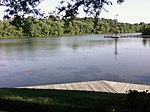Wilde Lake, Columbia, Maryland

Wilde Lake is a man-made drainage reservoir dug in 1966 and the name of the surrounding "village" of neighborhoods located in Columbia, Maryland, just north and west of Columbia Town Center. The village was the first part of Columbia's "New Town" to be built in the late 1960s, James W. Rouse and Frazar B. Wilde formally opened the neighborhood on June 21, 1967. The lake and village are named for Frazar B. Wilde, a past chairman of the board of Connecticut General Life Insurance Company and former employer of James Rouse. In 1963, the company agreed to fund the secret land purchases and, in return, acquired an equity participation. This arrangement was subsequently formalized by the creation of The Howard Research and Development Corporation, the joint venture established to develop Columbia.
Excerpt from the Wikipedia article Wilde Lake, Columbia, Maryland (License: CC BY-SA 3.0, Authors, Images).Wilde Lake, Columbia, Maryland
Catterskill Court, Columbia Wilde Lake
Geographical coordinates (GPS) Address Nearby Places Show on map
Geographical coordinates (GPS)
| Latitude | Longitude |
|---|---|
| N 39.225555555556 ° | E -76.866388888889 ° |
Address
Catterskill Court
Catterskill Court
21044 Columbia, Wilde Lake
Maryland, United States
Open on Google Maps








